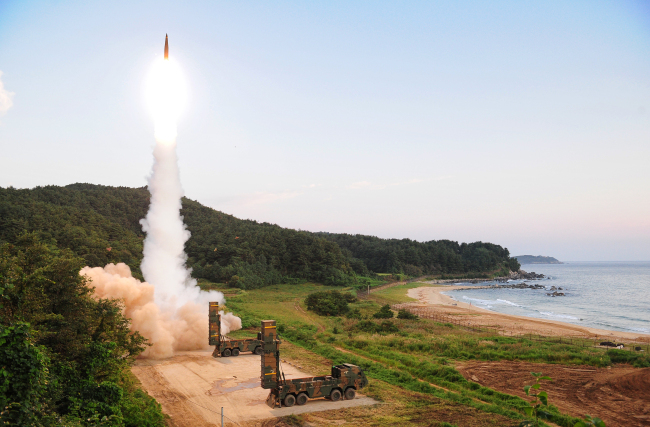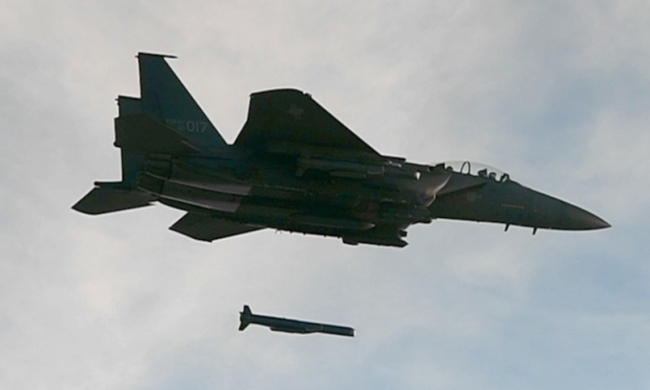Seoul hardens line on Pyongyang, eyes powerful US arms
By Choi He-sukPublished : Sept. 4, 2017 - 18:34
Seoul’s North Korean policies will shift to give military issues more weight as President Moon Jae-in seeks punitive measures “of the highest order” following Sunday’s nuclear test, it was revealed Monday.
Speaking to the parliamentary defense committee, Minister of National Defense Song Young-moo said that the shift was decided at Sunday’s National Security Council meeting.
“At yesterday’s NSC meeting, the consensus was that the direction the government should take is strengthening (readiness in the) military standoff rather than (focusing) on dialogue or the Berlin initiative,” Song said.
Speaking to the parliamentary defense committee, Minister of National Defense Song Young-moo said that the shift was decided at Sunday’s National Security Council meeting.
“At yesterday’s NSC meeting, the consensus was that the direction the government should take is strengthening (readiness in the) military standoff rather than (focusing) on dialogue or the Berlin initiative,” Song said.

The Berlin initiative refers to President Moon’s diplomacy-focused plans for engaging North Korea and to pursue peace on the peninsula. The plans were announced in Berlin, ahead of July’s G-20 Summit.
Song also revealed that the Ministry of National Defense considers it likely that Pyongyang is now capable of mounting nuclear warheads on ballistic missiles, and there are signs that North Korea could conduct another ballistic missile test.
The Defense Ministry, however, later added that Song had meant that the warhead revealed by Pyongyang's state media was of a size small enough to be mounted on a missile, and that it has not been confirmed that what was shown by North Korean media is a real warhead.
The possible shift in Seoul’s North Korean policies was revealed hours after Moon reiterated the need for tougher measures against Pyongyang in his telephone conversation with Japan’s Prime Minister Shinzo Abe.
During a 20-minute telephone conversation Monday, Moon and Abe condemned North Korea’s violation of UN Security Council resolutions and promised tougher action against the North.
According to Cheong Wa Dae spokesman Park Soo-hyun, the two leaders consider North Korea to have taken its provocations to a “new dimension” and agreed on the need for a concerted response.
“(Moon) emphasized (the two countries must) work with the international community to bring strong and real responses of a new level that can be felt by North Korea,” Park said.
“The two leaders shared the view that North Korea should be subjected to pressure and sanctions of the highest order, and to push for stronger UN Security Council sanctions.”
Along with diplomatic and economic measures, South Korea and the US are currently in talks to bring tactical US military assets in a show-of-force maneuver, the Defense Ministry said.
Song also revealed that the Ministry of National Defense considers it likely that Pyongyang is now capable of mounting nuclear warheads on ballistic missiles, and there are signs that North Korea could conduct another ballistic missile test.
The Defense Ministry, however, later added that Song had meant that the warhead revealed by Pyongyang's state media was of a size small enough to be mounted on a missile, and that it has not been confirmed that what was shown by North Korean media is a real warhead.
The possible shift in Seoul’s North Korean policies was revealed hours after Moon reiterated the need for tougher measures against Pyongyang in his telephone conversation with Japan’s Prime Minister Shinzo Abe.
During a 20-minute telephone conversation Monday, Moon and Abe condemned North Korea’s violation of UN Security Council resolutions and promised tougher action against the North.
According to Cheong Wa Dae spokesman Park Soo-hyun, the two leaders consider North Korea to have taken its provocations to a “new dimension” and agreed on the need for a concerted response.
“(Moon) emphasized (the two countries must) work with the international community to bring strong and real responses of a new level that can be felt by North Korea,” Park said.
“The two leaders shared the view that North Korea should be subjected to pressure and sanctions of the highest order, and to push for stronger UN Security Council sanctions.”
Along with diplomatic and economic measures, South Korea and the US are currently in talks to bring tactical US military assets in a show-of-force maneuver, the Defense Ministry said.

Seoul’s Joint Chiefs of Staff, which promised such exercises Sunday, said that the allies are discussing plans to bring the latest US military hardware to the region to demonstrate capabilities.
According to reports, Seoul and Washington are leaning toward exercises mainly involving naval and air force assets on and around the Korean Peninsula. US assets considered likely to be mobilized include F-22 and F-35B fighter jets, B-1B and B-52 bombers, the aircraft carrier USS Ronald Reagan and nuclear-powered submarines stationed in Japan and Guam.
In addition, the allies are said to be discussing plans for stationing additional US military assets in South Korea. According to reports, options under consideration in Washington include stationing F-22 and F-35B fighter jets at US military bases in Korea on a three-month rotational basis and expanding the US Air Force presence here on a longer-term basis.
South Korea kicked off the demonstration of military capabilities in the early hours of Monday, with Army and Air Force units conducting live-fire missile drills on the east coast of the country.
In the drill, surface-to-surface and air-to-surface missiles were fired at an area about 300 kilometers off the coast in the East Sea as a demonstration that South Korea is fully capable of striking North Korea’s nuclear facilities, the JCS said.
According to the Defense Ministry, this is the first missile drill in which the North’s Punggyeri nuclear weapons testing facility was specified as the target.
In its report to the National Assembly’s defense committee, the ministry also said that another unilateral live-fire drill involving Taurus air-to-surface missiles mounted on its F-15 K fighter jets will be conducted later this month.
South Korean politicians also responded to Sunday’s development, with the National Assembly adopting a resolution condemning North Korea. In the resolution, the National Assembly called on the South Korean government to review its North Korean policies and to take stronger action while warning North Korea that it was heading for “international isolation and self-destruction.”
By Choi He-suk (cheesuk@heraldcorp.com)
According to reports, Seoul and Washington are leaning toward exercises mainly involving naval and air force assets on and around the Korean Peninsula. US assets considered likely to be mobilized include F-22 and F-35B fighter jets, B-1B and B-52 bombers, the aircraft carrier USS Ronald Reagan and nuclear-powered submarines stationed in Japan and Guam.
In addition, the allies are said to be discussing plans for stationing additional US military assets in South Korea. According to reports, options under consideration in Washington include stationing F-22 and F-35B fighter jets at US military bases in Korea on a three-month rotational basis and expanding the US Air Force presence here on a longer-term basis.
South Korea kicked off the demonstration of military capabilities in the early hours of Monday, with Army and Air Force units conducting live-fire missile drills on the east coast of the country.
In the drill, surface-to-surface and air-to-surface missiles were fired at an area about 300 kilometers off the coast in the East Sea as a demonstration that South Korea is fully capable of striking North Korea’s nuclear facilities, the JCS said.
According to the Defense Ministry, this is the first missile drill in which the North’s Punggyeri nuclear weapons testing facility was specified as the target.
In its report to the National Assembly’s defense committee, the ministry also said that another unilateral live-fire drill involving Taurus air-to-surface missiles mounted on its F-15 K fighter jets will be conducted later this month.
South Korean politicians also responded to Sunday’s development, with the National Assembly adopting a resolution condemning North Korea. In the resolution, the National Assembly called on the South Korean government to review its North Korean policies and to take stronger action while warning North Korea that it was heading for “international isolation and self-destruction.”
By Choi He-suk (cheesuk@heraldcorp.com)



![[Herald Interview] 'Amid aging population, Korea to invite more young professionals from overseas'](http://res.heraldm.com/phpwas/restmb_idxmake.php?idx=644&simg=/content/image/2024/04/24/20240424050844_0.jpg&u=20240424200058)













![[KH Explains] Korean shipbuilding stocks rally: Real growth or bubble?](http://res.heraldm.com/phpwas/restmb_idxmake.php?idx=652&simg=/content/image/2024/04/25/20240425050656_0.jpg&u=)

